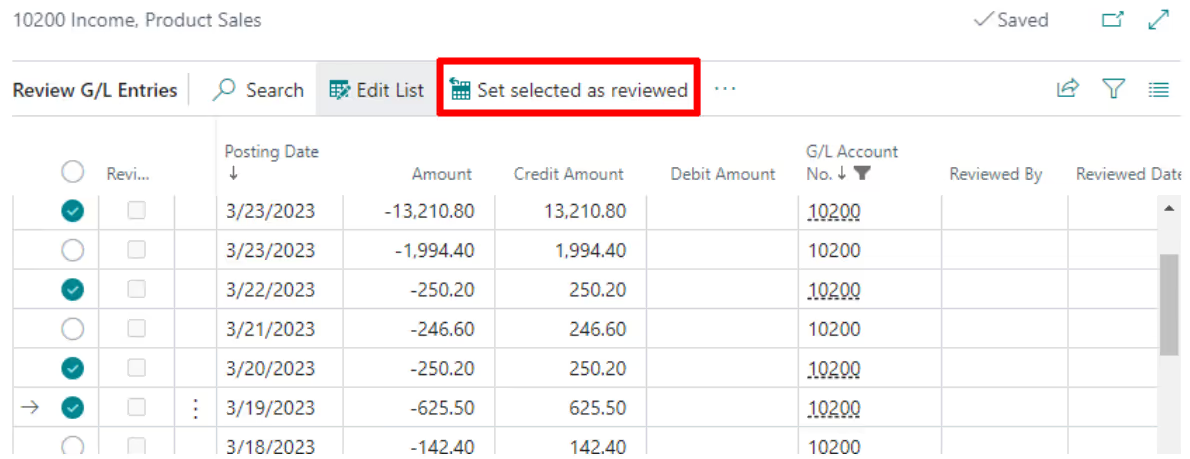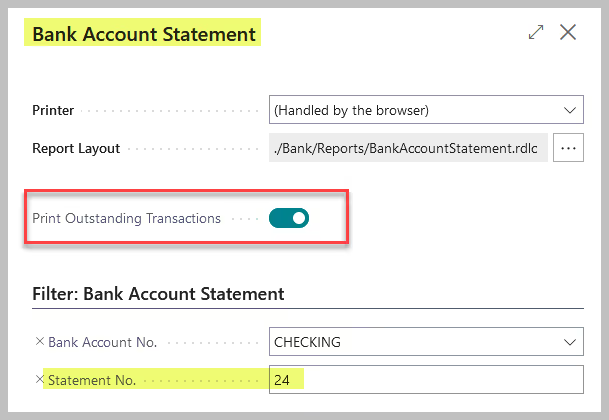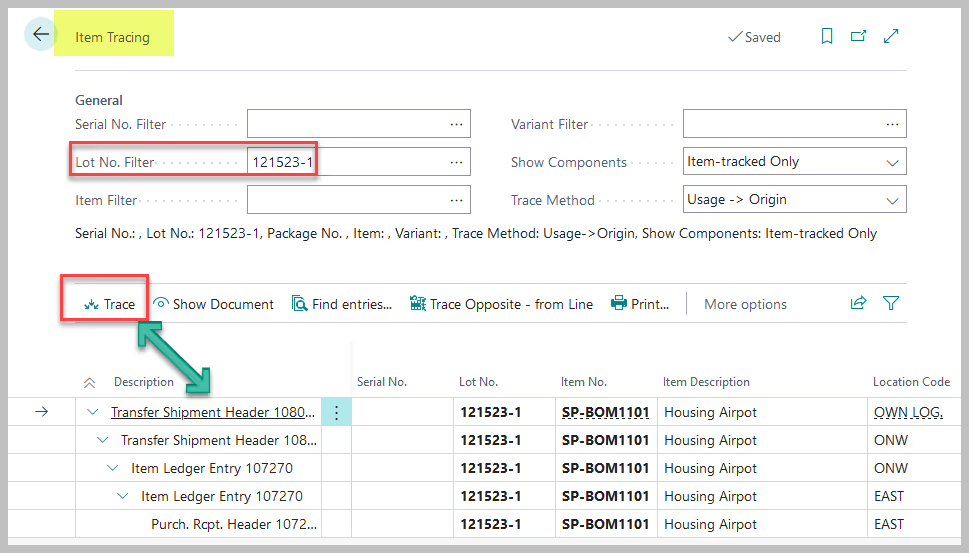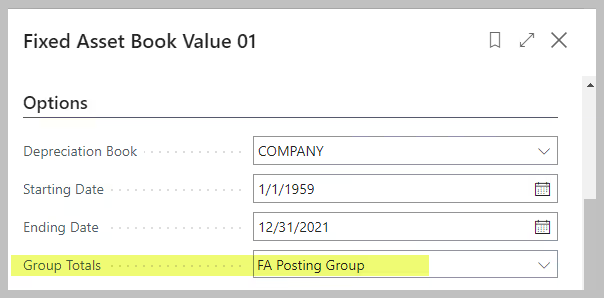
The Auditors Are Here! Keep Calm and Read On
It’s ‘that’ time of year again and you’ve just been handed a list of reports the auditors have asked for and you start scrambling. You know they have to be here somewhere in the Microsoft Dynamics 365 Business Central list of available reports but which one will fit the requirement?
Depending on your business, that list the auditors handed you is going to be somewhat different for everyone using Business Central (BC) but here are some of the common requests along with how to provide the information.
G/L Entry Review
Business Central has added a new G/L entry review feature to help you be better prepared for your audit. With this feature, you are now able to reconcile entries within a G/L account and mark them as reviewed with a time and user ID stamp. To review entries posted to a G/L account you will need to select one of the following options on the G/L Account Card:

Option 1: None. You can't mark entries for the account as reviewed. For example, use this option for accounts such as payables, receivables, and bank accounts where there are other ways to review their amounts.
Option 2: Allow Review (Allows entries to be marked as reviewed without any particular restrictions)
This setting allows you to remove a review from one or more entries. Currently, since this feature only allows for review within a single g/l account, this is not an option that will be used very much.
Option 3: Review allowed and match balance. The total amounts of the debit and credit entries in the review must match. The Debit and Credit fields show those amounts, and the Balance field shows the total. This setting lets you remove a review. When you remove a review from one or more entries, the debit and credit entries must still balance.
When ready to review, go into the specific G/L account, select the entries you would like to reconcile and mark as reviewed and then click on Set selected as reviewed in the ribbon.

Entries are then marked as reviewed with the timestamp and who reviewed them. If you mark an entry/entries as reviewed in error, you can mark them as not reviewed and start again.
After you complete the review for the account you can click on the show review entries and export that view out to excel as well.

Analysis mode on the list pages in BC
The auditors are sure to ask you for multiple reports which now can be created with ease right from the list pages in BC. With the new Analysis mode, you can generate reports directly from the list pages instead of searching for and running the reports and trying to figure out which filters to use to run the report.
For example, if you would like to look at the aged AR without running the Aged AR report you can use the Analyze function to build the report easily from the Customer Ledger Entries page. Go to the customer ledger entries page and turn on the Analyze toggle switch. Once in Analysis mode you can manipulate and use the different areas as shown in the screenshot below to manipulate, summarize and analyze the data.

Once you have the information you need from the data, you can export the data to excel or csv format by right clicking on the data area and clicking on export to excel or csv.
Once done with your analysis, you can turn off the Analyze toggle switch and exit the Analyze Mode.
The Analyze mode can also be used effectively to generate various financial reports and you can save different analysis views that will always show up when the Analyze toggle for that page is turned on.
Posted and Applied Documents
Auditors love to ask for a posted Sales or Purchase Invoice along with all the related shipments and receipts. Typically, you can reprint these without any problems from the Posted Sales Invoice or Posted Purchase Invoice lists. Then use the order numbers to find the related shipments or receipts they will also want to see. Note: Use the ‘Order No.’ in a filter to find the related shipments or receipts as there could be multiple.
If they ask for a copy of the original Order, you may have a problem if the order has been completely invoiced. In this scenario, you can provide a copy of the Order IF your system has been setup to auto-archive a copy or someone has manually archived a copy of it.
The setup pages for both Sales and Purchases will have an option to automatically archive Orders prior to the system deleting them. If this is activated, you will have a list of your Orders in the Sales Order Archive or Purchase Order Archives lists or if your users have manually triggered an archive prior to it being deleted.

Should they ask for a report showing the payment applications to the invoices, you can give them the Customer Account Detail report or the Vendor Account Detail report which will show the application of the payments.

Be sure to select ‘Print Additional Details’ if you want the report to show the applications. You will also want to enter a Customer No. or Vendor No. filter and date filters for the auditors’ requested files else you end up with an enormous amount of data.

The other standard report you will need to provide is the open aging for both receivables and payables (search Aging to see summary and detailed report options). These are standard reports and can be recreated at any time for any date range requested.
Trial balance reports
Business Central has many different trial balance reports with a variety of styles and layouts. We find the Trial Balance Detail/Summary report to be helpful if your Balance Sheet account does not have a supporting detailed report already.
For example, you have a balance sheet account for ‘Employee Advances’ but it does not include a supporting detail report like your Accounts Receivable account’s ‘Aged Accounts Receivable’ report. Running the ‘Trial Balance Detail/Summary’ report with ‘Print Transaction Detail’ selected will print all the account transactions rather than just the account balance. Note: Always filter on one account number when you select to print the account detail or you could get an enormous amount of data.

Financial Statements
As most of you are already aware, if you add a new Chart of Account, your financial reports (search Financial Report) do not dynamically update with the new account. They must be manually updated with the new account information. Depending on how you built your subtotals and totals, the account’s value may be included but the details may not add up correctly if you take a close look. Note for more information on setting up Financial Reports (formerly called Account Schedules) follow this link to Microsoft learn or reach out with any questions.
Prior to handing over any financial reports to an auditor, we suggest doing a manual comparison to a trial balance report to be sure all G/L Accounts are included and all subtotals and totals are ticking and tying properly.
In addition, if you use analysis views, make sure they have been properly updated as well.
Financial reports can be run for any period of time at any time they are requested.
Bank Reconciliations
To reprint a Bank Reconciliation, navigate to the Bank Account card and find the menu option for Statements.
In the list that opens, you can find the requested statement by the Statement Date. Then use the Statement No. in your filter when running the report.

Be sure to select the ‘Print Outstanding Transactions’ option as the auditor will want that information included. This option will include all transactions for the period not cleared during the bank reconciliation process. Otherwise, the report will only include cleared transactions.

Inventory Balances
The Inventory to G/L Reconcile report will reconcile the balances of the Inventory related G/L accounts along with the interim accounts, if used. Depending on how you selected to use the General Posting Setup and the Inventory Posting Setup, this report may need to be run with filters to tie to the specific accounts.
This report can be produced any time for any ‘as of date’ as needed.
In addition, the auditor may ask to see entries for any physical count adjustment made for a particular item. You can find these by navigating to the Phys. Inventory Ledger Entries page while on the Item card. Or if they want to see all items adjusted for a specific date, you can find that in the ‘Posted Physical Inventory Order’ page.
If they want to audit your physical counting process, you can create a Physical Inventory Order or Physical Inventory Journal with the appropriate filters for their requested sample count.
For tracing Serial No.’s or Lot No.’s, use the Item Tracing functionality. Enter the Serial No. or Lot No. and then click ‘Trace’ to see where and how that Serial No. or Lot No. traveled through the system.

Fixed Assets
If the auditor requests a report of your fixed assets that includes the ‘Serial No.’ field, use the Fixed Asset – List report. This report will only include the asset details and not any of the acquisition costs or depreciation costs. Very few of the reports include the Serial No. field so if you need a report that includes it and related asset values, you may need to make a modification to a report.
Most of the Fixed Asset related reports will give you the values that will support the balance sheet accounts for the assets. If the Fixed Asset Posting Groups correlate to your various asset accounts, then select to subtotal by the FA Posting Groups when running these reports for easier reconciliation.

Audits can be overwhelming to pull together all the information you need at a moments request.
Reach out to us, if you need guidance or support.
